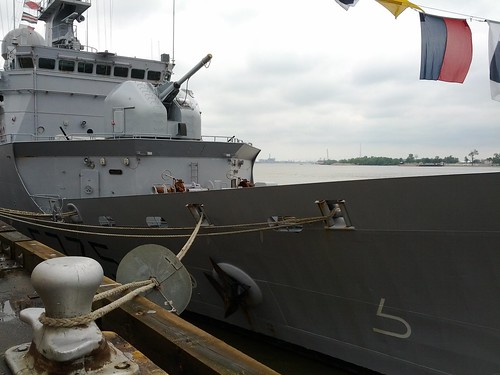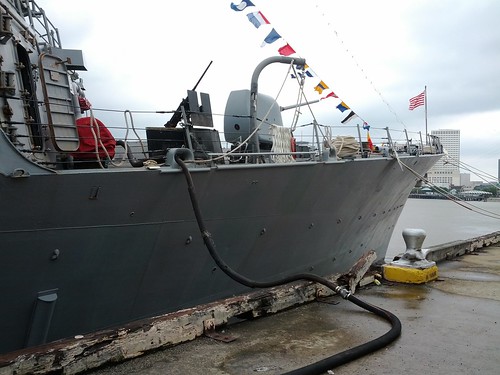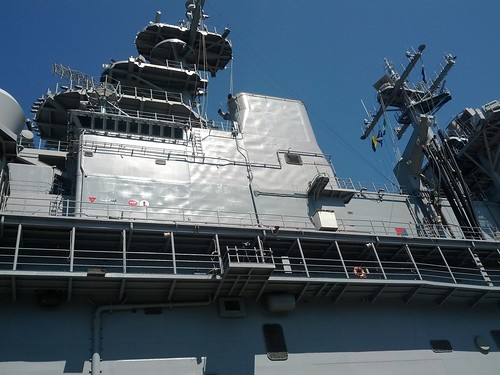While waiting in line I took this photo of the superstructure of the USS Wasp. Note the 'wrinkled' appearance of the plate. One might ask how is extremely strong plate wrinkled? Here's a hint: that didn't happen from wear and tear; the USS Wasp left the shipyard looking like that.
In the old days of battleships, the Navy never had this problem. 12" of battleship armor doesn't like deforming. Now, the Navy has shifted to using very thin, very strong steels. 90% of plate steel used in modern Navy shipyards is 10mm thick or less. The plate is extremely strong; old steel might only be 30-ksi, while modern steels (like HSLA) are 100-ksi. The Navy has been using these high yield steels since the early Nimitz-class carriers.
How can you work these high strength steels into the curves and complex geometry of a ship? Well, not with bending. They are too strong and you'll either need too much force or you'll deform the steel. On the other hand, if you use the steel's own properties against itself, you can easily deform it. All materials are subject to thermal expansion. If you heat up the steel enough in just the right way, you can induce the curves that are present in the hull of a ship.
Why is the photo wrinkled? Well, how do you put a modern naval ship together: Welding, a thermal process. The deformation is from welding. The Navy has also been tearing their hair out trying to resolve these wrinkles for the past 20 years. There are all sorts of reasons the Navy is concerned, but one big one is radar signature. The curves reflect radar waves extremely well and make the Wasp look like, well, an aircraft carrier on radar. It makes it extremely easy for an Exocet to home in...
Solving this problem is a hot research area. UNO happens to be at the forefront of a lot of this research.
Saturday, April 28, 2012
Major plate distortion
Sunday, April 22, 2012
A Naval Architect goes to NOLA Navy Week
I had a little detail I wanted to point out that I noticed in Navy Week.
First off, what is Naval Architecture? Well, ABET recognizes 3 very closely-related disciplines: Naval Architecture, Marine Engineering, and Ocean Engineering. Naval Architecture generally concerns hull forms, Marine Engineering usually concerns engines, propulsion, and ship systems, and Ocean Engineering is sort of civil and mechanical at sea. Here's a nice little paper describing more along these lines.
So, one of the things I noticed this weekend was the differences in hull geometry between the 3 vessels at the Governor Nicholls Wharf. In the photo below, the USS Mitscher is first, followed by the USS DeWert, with the French Frigate Germinal last:

The DeWert is the oldest design of the three. It's an Oliver Hazard Perry-class frigate. It has a hull geometry that was very similar to WWII-era designs. As a result, its sea-keeping abilities leave something to be desired. Here are some photos of a Knox-class frigate, the OHP-class predecessor, trying to cope with 45'+ waves. "Green water over the bow" is when you start to really get worried. Here are some even more amazing photos of similar-sized military ships coping with big waves.
I got to talking with a seaman on the DeWert and he wished the ship had a wider beam. There are three stages of sea-sickness: seasick, so seasick you're afraid you're going to die, and so seasick you're afraid you AREN'T going to die and it will never end. You could tell he'd been the third category of seasick at some point in his naval career.
The other two vessels are much more modern and had some interesting design characteristics to cope with heavy seas.
The FS Germinal had a double-decked bow. More photos here.


The lower deck held the anchor-handling gear (windlass, etc.) and the upper deck held the armament (something you really don't want getting wet). The lower deck you can tell is regularly awash, due to the extensive corrosion. The advantage is there's less of the bow to get sucked-under when it does go awash and the upper deck stays much dryer. The disadvantage is the lower deck is regularly awash and I'd be willing to guess the design is a bit heavier.
The Mitscher is the largest of the three vessels, but not by that much. From talking with the destroyer's crew, it is a very, very seaworthy vessel. One of the main reasons is the intricate chine on the bow:

It was the result of a lot of studies of behavior of especially OHP-class ships in the North Atlantic. The design keeps the deck relatively dry by allowing just enough movement, but not so much that either the crew get seasick or the sonar-dome goes out of the water.
So, if you're a Naval Architect, these are the sorts of decisions that you need to make. The net result of all the decisions and compromises results in the final design of the ship.
NOTE- Some updates after publishing
Front of the French Quarter, covered in Tall Ships
You'd have to go back well over 100 years to see this sight again...
NOLA Fleet Week
Hope you went. I spent much of last week's lunch breaks hanging out under the shade of tall ships reading Horatio Hornblower.


